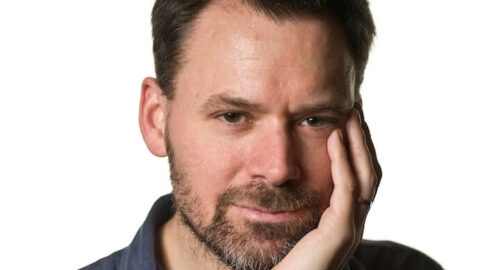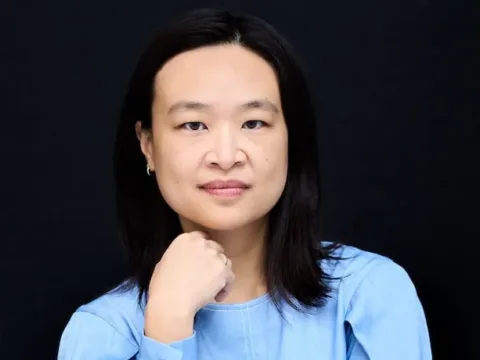Over the last ten years, Red Note Ensemble has projected itself into the musical and social fabric of urban and rural Scottish life, responding to the cultural beat of new music in Scotland. John Harris heads up the contemporary music ensemble as its CEO and Co-Artistic Director, negotiating the group’s broad commitments and responsibilities as performers, advocates, commissioners, and collaborators.
As the brief warmth of Scottish summer takes an icy turn, Red Note Ensemble is following its audiences into the cosier, more sociable parts of town, flooding Glasgow, Edinburgh, and Aberdeen with 30 new works by young new music composers in Scotland. So new, in fact, that a third of the works will be selected and workshopped from open calls for scores, giving voice to young emerging composers. With the belief that people are curious, interested, and open to new sounds, the series, known as Noisy Nights, gives listeners and composers the opportunity to find something or someone new. We asked John Harris five questions about the value of new music and culture for new audiences.
In Noisy Nights, Red Note continues to commission and collaborate with young artists. What do you find most inspiring in the compositional voices of new music composers?
Ever since we founded Red Note ten years ago, we have been dedicated to championing new and emerging talent, especially young composers from Scotland. Our aim to support the talent of tomorrow through commissions, talent development schemes, and involvement with music colleges and conservatoires nationally and internationally has always lain at the heart of what we do.
Noisy Nights is our “open mic night” initiative for young composers, which we’ve been running since we started Red Note in 2009–it’s actually our oldest project! It’s a place for a wide, democratic audience, music-lovers and curious minds alike, to meet in an informal space to hear and experience new musical ideas and voices. We make a call for scores for a specific line-up, invite composers to quiz our players in a live instrument demo on Facebook and YouTube, before then performing the selected scores live in an informal venue, usually over a pint of beer! Noisy Nights returns to Glasgow’s The Drake pub on 20 November, and further Noisy Nights will be taking place in the New Year.
For me, the most inspiring thing is that young composers bother to take part in such initiatives at all! To get musical ideas down in a form that can be performed by others, to send those ideas off in to the void in the hope that someone will pay attention to them, and then, if the music is performed, to have it listened to (often critically) by others; those are big steps for new and inexperienced composers. Sometimes I wonder whether it’s worse to not have your music selected, or to have it selected, given that you may be trying something new for you and the reception your music will receive is uncertain. It’s frightening if you care about what you’ve just made.
We actually find ourselves working earlier and earlier with composers: last week we were working with a group of teenagers in Levenmouth High School in Fife as part of our New Music Makers project with 16- to 18-year-olds, enabling them to create their own music for us to play. Prior to that, we were at the Sound Festival (Aberdeen)’s “Go Compose!” Programme doing the same thing with a slightly wider age range. Last year, we were in Oakwood Primary School in Easterhouse working with every single class to create their own music. We’re recognising that the skills and confidence to express yourself musically don’t suddenly appear fully formed at the Noisy Nights stage–they need to be nurtured right from the very earliest stages.
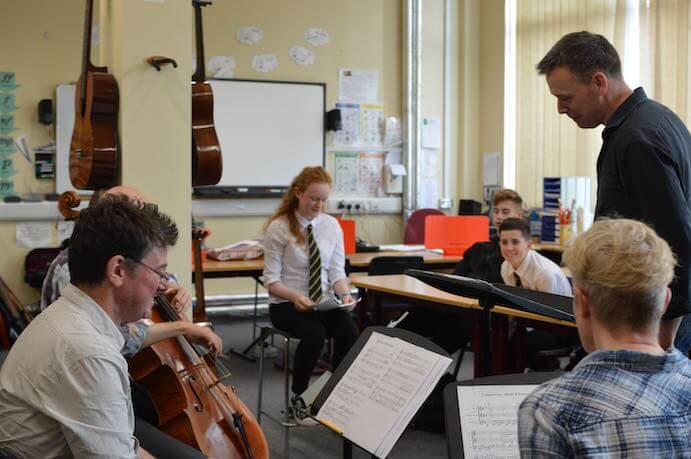
Across all your advocacy and performance of new music, a genre which can often be perceived as challenging or complex, what do you see as the most significant and immediate challenges in presenting that music to new audiences?
I think there are serious issues with what one might describe as classically-based work. I think that it still has a very major image and access problem. Nobody is talking about it properly, and the efforts to change perceptions are paper thin. We’ve commissioned a lot of in-depth research looking not only at who already engages with our work, but also those who don’t and why. Qualitative research we have done with QUAL at Edinburgh University has opened up our understanding of the choices audiences make, why they make them, and what drives those choices. This has demonstrated a public appetite for contemporary music, including within some of the hardest-to-reach audiences in Scotland, dispensing and disproving the commonly-received notion that new music audiences must be a sub-set of classical music audiences. Instead, as a result, we are establishing ways of engaging directly with multiple diverse audiences in multiple different settings.
What we have found is that there is an enormous appetite from people from all social classes for the work we do, and that the barriers preventing access and engagement with contemporary music are in fact social and logistical, not musical or artistic. I think we for far too long have expected people to cross our threshold (the concert hall and the palaces we erect for the arts), but it’s about time we started crossing–invited, ideally–into our audiences’ thresholds to enable them to make their own social uses for the stuff we make.
We know that audiences out there are up for experiencing new stuff: the existential danger for composers and performers who are putting themselves out there is that people are not going to like it. However, if we don’t present new music with an open heart, an open mind, and a readiness to accept the audience’s responses–and to engage with them with the same open-hearted way that they are approaching us–then we’ll be going around the same self-defeating cycle all over again.
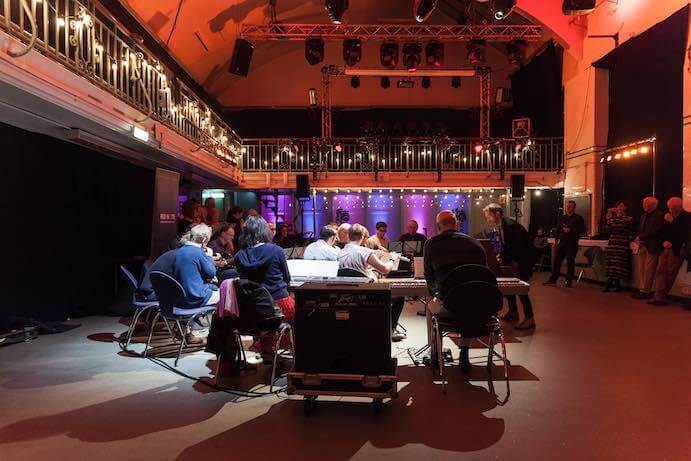
In thinking about listeners, particularly those new to contemporary music, what experience, response, or reflection do you understand they might be surprised to discover?
I think the surprise is for the composers and performers, and that surprise is that audiences are absolutely up for it! To be frank, most current audiences for concert music–the dreaded “classical music” audiences–are bored rigid most of the time. A large number are asleep in their seats. Many are only there because their social circle are there, and they come out of habit and the chance to chat with their friends in the interval. New music has the ability, and possibility, to re-awaken audiences’ interest and delight in musical discovery, but only if audiences are allowed by us not to like it.
Audiences need to be allowed to make up their own minds, they need to not be made to feel stupid for “not getting it,” and they need to be enabled to voice their thoughts on what they’ve just heard. Fundamentally, they need to be allowed to recognise their own humanity in the humanity of the musicians and composers they have come to witness, and they need to be enabled to express that. In this way, too, we broaden the circle of listeners, rather than constricting it.
[Tweet “New music has the ability, and possibility, to re-awaken audiences’ interest and delight in musical discovery, but only if audiences are allowed by us not to like it.”]
Participating in the contemporary music scene, we can begin to see a familiar set of faces. What attitudes do you believe artists ought to adopt to steer clear of a culture that plays only to itself?
The truth of “new music” as a form is that it is supposed to be exploratory and experimental, and that has both positives and negatives for those working within it. The positive is that there’s always the chance that something wonderful, striking, and new will appear that no-one else has dreamed of: that happens maybe once, twice, three times in a generation. The downside is that this endless chase after newness–which is itself, I think, an anxiety that is largely born of the retreat of “new music” into academia and the inevitable comparisons made there between academic science (which discovers new stuff on a regular basis) and music (which doesn’t, and is therefore trapped in an endless cycle of justifying itself in this falsely competitive arena)–creates a terrible defensiveness. This defensiveness–“I don’t care if you don’t like what I’ve written!” or its more aggressive twin, “You’re not capable of understanding my music!”–increasingly marginalises new music as it pushes away those who are not within the closed and constrictive circle of admirers/cognoscenti/new music ghetto inhabitants/misunderstood artists/self-declared geniuses/call them what you will, and by exclusion, simply bolsters the self-justification of those within it. It then follows, because no one inside the circle can move for fear, that new music suffers a form of both social and artistic paralysis.
As a consequence, what I find particularly inspiring, given these barriers and tendencies, are composers who have an open-hearted will to reach others with what they’ve written, and a willingness to engage with listeners on their terms. Those are unusual gifts in new music composers and must be cherished when we find them! They are the future.
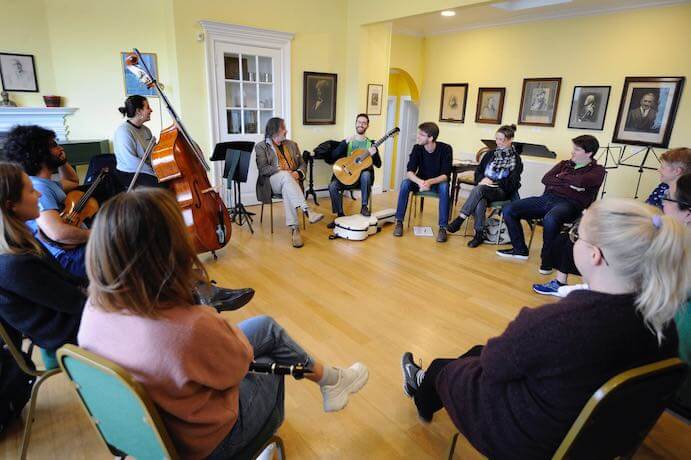
With our emotional, political, and moral attention occupied by the scale of environmental and cultural crisis, in what ways do you see art music finding its way into the everyday lives of people?
Connecting people and their communities through music is central to Red Note’s identity and philosophy, and we certainly view ourselves as an ensemble with a social mission. We work hard to bring new music to new destinations–to pubs, clubs, bothies, shopping centres, care homes, and schools–as well as to well-known concert halls and major festivals. We have a very strong sense that what we do should never be exclusive and that new music composition and creativity is something that everybody should be able to access and engage with.
We take a diverse and inclusive approach to creative learning, grounded in the belief that music is a universal language that can be understood and used by everybody, and this element of our work has grown and grown over the last decade. Our musicians engage with communities across Scotland via a programme of workshops, projects, and performances, generating opportunities for people of all ages, abilities, and backgrounds to access, engage, and have fun with new music. We deliver everything with the same intense level of dedication and excellence, whether performing with school children in local Scottish communities or on the stages of Europe’s greatest concert halls and festivals. It’s the same players performing the same music whether they are performing it at the Huddersfield Contemporary Music Festival or in one of the most deprived areas in Scotland.
At the core of Red Note’s access, engagement, and participation is our long-term 5 Places project. Targeting five locations across central Scotland over a period of several years, the project’s aim is for us to properly get to know people at all ages and stages in their own neighbourhoods at a grassroots level, and work with them to develop creative music-making in the heart of their communities. We are into our second year working within Easterhouse, and are just beginning to work in Methil; next year, we will start in Ferguslie Park in Paisley, with the two final places commencing in subsequent years. We also offer work for and with the community in short- or long-term projects such as our ground-breaking ‘musical conversations’ with people with severe disabilities (at Cherry Road Centre Resource Centre, Bonnyrigg, in partnership with the Artlink arts-access-for-all organisation), concerts for the elderly in Residential Care Homes, and music for, with and by refugees.
Music is a social form: people gather together to participate in witnessing it and making it. I suppose my ideal is drawn from my upbringing in, curiously, the old Church of England. What has always struck me as being funny–and wonderful–about that strange, stuffy, and anachronistic old institution is that you could be in a church in any corner of the country, and be part of whatever was going on ritual-wise, but you hadn’t the faintest clue what the beliefs of the person next to you actually were. Likewise, you were free to think and believe for yourself as you saw fit. However, what was recognised as most important was that we were all there and we were all in the same place, in our own, different and various ways. We don’t all think the same.
If there is a function for new music, I can see that it does exactly that: it can offer a place and a reason for us all to gather together, to connect with each other, in acceptance of our differences and uniquenesses. The world needs that.
